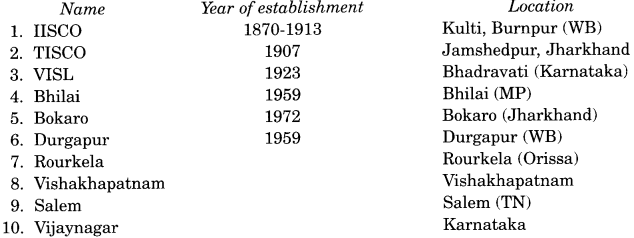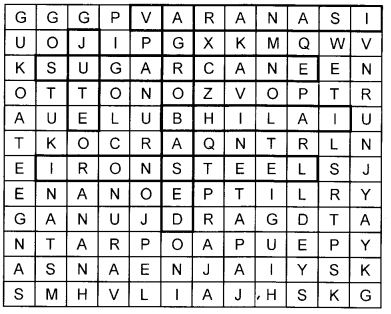NCERT Solutions for Class 10 Social Science Geography Chapter 6 Manufacturing Industries
These Solutions are part of NCERT Solutions for Class 10 Social Science. Here we have given NCERT Solutions for Class 10 Social Science Geography Chapter 6 Manufacturing Industries.
TEXTBOOK EXERCISES
l. Very Short Answer Questions :
Question 1.
(a) Which industry uses limestone as a raw material ?
(b) Which agency markets steel for the public sector plants ?
(c) Which industry uses bauxite as a raw material ?
(d) Which industry manufactures telephones, computer etc.
Answer:
(a) Cement.
(b) Sail.
(c) Aluminium.
(d) Electronic industry.
Question 2.
Answer the following briefly in not more than 30 words :
- What is manufacturing?
- Name any three physical factors for the location of the industry.
- Name any three human factors for the location of an industry.
- What are the basic industries? Give an example.
- Name the important raw materials used in the manufacturing of cement?
Answer:
- Production of goods in large quantities after processing from raw materials to more
valuable products is called manufacturing. For example, the paper is manufactured from wood, sugar from sugarcane and steel from iron ore, and aluminium from bauxite. - Three physical factors for the location of the industry are as given below :
- Near to the raw material.
- Nearness to power i.e., sources of power generation.
- Climate particularly in the establishment of agro-based industries like cotton and jute textile.
- Three human factors for the location of an industry are as mentioned below :
- Labour – It may be skilled or unskilled.
- Transport facilities – Good transport is needed to bring the raw material to the industries as well as to take finished goods to the market.
- Demands for goods – There should be demands for goods so that the goods may be purchased and consumed. Some goods may ribbed to the good purchasing power of the people around the industries.
- Basic industries are those industries which supply their products or raw materials to manufacture other goods e.g., iron and steel and copper smelting, aluminium smelting industries.
- The important raw materials used in the manufacturing of cement are limestone, silica, alumina, and gypsum.
Question 3.
Write the answers to the following questions in 120 words :
(1) How are integrated steel plants different from mini steel plants? What problems does the industry face? What recent developments have led to a rise in production capacity?
(2) How do industries pollute the environment?
(3) Discuss the steps to be taken to minimise environmental degradation by industry? [CBSE 2016]
Answer:
(1)
- Integrated steel plants are large.
- They handle everything in one complex – from putting together raw material to steel making, rolling and shaping.
- These plants manufacture everything from alloy to steel.

(2) Mini Steel Plants :
- Mini steel plants are smaller, have electric furnaces, use steel scrap and sponge iron.
- They have re-rollers that use steel ingots as well,
- They produce mild and alloy steel of given specifications.
(3) The following problems are being faced by this industry —
- High costs and limited availability of coking coal,
- Lower productivity of labour
- Irregular supply of energy and
- Poor infrastructure.
(4)
(1) Liberalisation and Foreign Direct Investment have led to a rise in the production capacity of steel industry. Efforts of private entrepreneurs have given a boost to the industry. However, there is a need to allocate resources for research and development to produce steel more competitively.
(2) Industries have increased pollution and degraded environment. Industries create four types of pollution, namely, air, water, thermal and noise. These are explained as given below :
1. Air pollution :
The smoke emitted by til’s industries pollute air and water badly.
- Air pollution is caused by the presence of high proportion of undesirable gases such as sulphur dioxide and carbon monoxide.
- Air borne particulate materials contain both solid and liquid particles such as dust, sprays mist and smoke.
- Smoke is emitted by chemical and paper factories, brick kilns, refineries and smelting plants, and burning of fossil fuels in big and small factories that ignore pollution norms.
- The gas leaks can be very hazardous with long term effects. For example, Bhopal Gas tragedy killed hundreds of people and adversely affected human health, animals, plants etc. as a whole.
2. Water pollution :
- The industrial effluents, both organic and inorganic, are discharged into rivers. They pollute the water.
- Coal dyes, soaps, pesticides, fertilisers are some common pollutants of water.
- The main industries that pollute water are paper, pulp, textiles, chemical, petroleum and electroplating.
- These industries let out dyes, detergents, acids, salts and heavy metals like lead and mercury pesticides into the water bodies.
Fly ash, phospho-gypsum and iron and steel slags are the major solid wastes in India.
3.Thermal pollution :
- Thermal pollution of water occurs when hot water from factories and thermal plants is drained into the rivers and ponds before cooling.
- Wastes from nuclear power plants, nuclear and weapon production facilities cause cancers, birth defects and miscarriages.
- Dumping of wastes specially glass, harmful chemicals, industrial affluents, packagings, salts and garbage renders the soil useless.
- Rain water percolates to the soil carrying the pollutants to the ground and the groundwater also gets contaminated
4. Noise pollution :
- Industrial and construction activities, machinery, factory equipment, generators, saws and other equipment make a lot of noise which have bad effects on human beings.
- It can cause hearing impairment, increased heart rate and blood pressure among other physiological effects.
- Unwanted sound is an irritant and a source of stress.
(3) Steps to be taken to minimise environmental degradation by the industry. Some suggestions to minimise environmental degradation are given below :
- To minimise use of water for processing by reusing and recycling it in two or more successive stages.
- Harvesting of rainwater to meet water requirements.
- Treating hot water and effluents before releasing them in rivers and ponds.
- Treatment of industrial effluents can be done in three phases as given below :
- Primary treatment by mechanical means. This involves screening, grinding, flocculation and sedimentation.
- Secondary treatment by biological process.
- Tertiary treatment by biological, chemical and physical processes. This involves recycling of waste water.
- There should be careful planning, siting of industries, better design equipment and better operation of the equipment.
- Overdrawing of groundwater reserves should be regulated legally.
- Particulate matter in the air can be reduced by fitting smoke stacks to factories with electrostatic precipitators, fabric filters, scrubbers and inertial separators.
- Smoke can be reduced by using oil or gas instead of coal in factories.
- Machinery and equipment can be used and generators should be fitted with silencers.
- Almost all machinery can be redesigned to increase energy efficiency and reduce
noise. - Noise absorbing material may be used apart from personal use of earplugs and earphones.
Question 4.
Give one word for each of the following with regard to industry. The number of letters in each word are hinted in brackets.

Answer:
(i) Power
(ii) Worker
(iii) Market
(iv) Retailer
(v) Product
(vi) Manufacture
(vii) Pollution.
Question 5.
Solve the puzzle by following your search horizontally and vertically to find the hidden answers.
1. Textiles, sugar, vegetable oil and plantation industries deriving raw materials from agriculture are called.
2. The basic raw material for sugar industry.
3. This fibre is also known as the ‘Golden Fibre’.
4. Iron-ore, coking coal, and limestone are the chief raw materials of this industry.
5. A public sector steel plant located in Chhattisgarh.
6. Railway diesel engines are manufactured in Uttar Pradesh at this place.

Answer:
- Agro-based
- Sugarcane
- Jute
- Iron Steel
- Bhilai
- Varanasi.
We hope the NCERT Solutions for Class 10 Social Science Geography Chapter 6 Manufacturing Industries help you. If you have any query regarding NCERT Solutions for Class 10 Social Science Geography Chapter 6 Manufacturing Industries, drop a comment below and we will get back to you at the earliest.